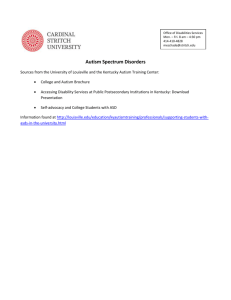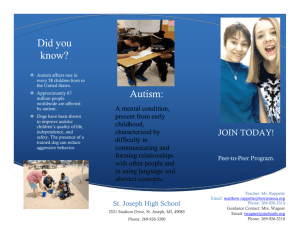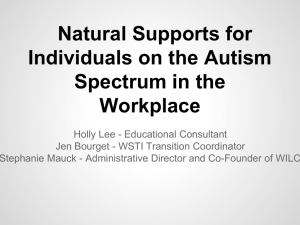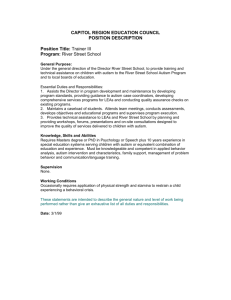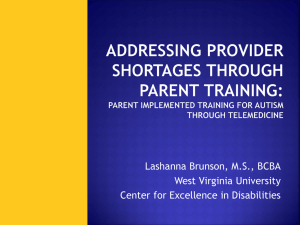Peer Review Paper: Social Inclusion of Students with Autism
advertisement
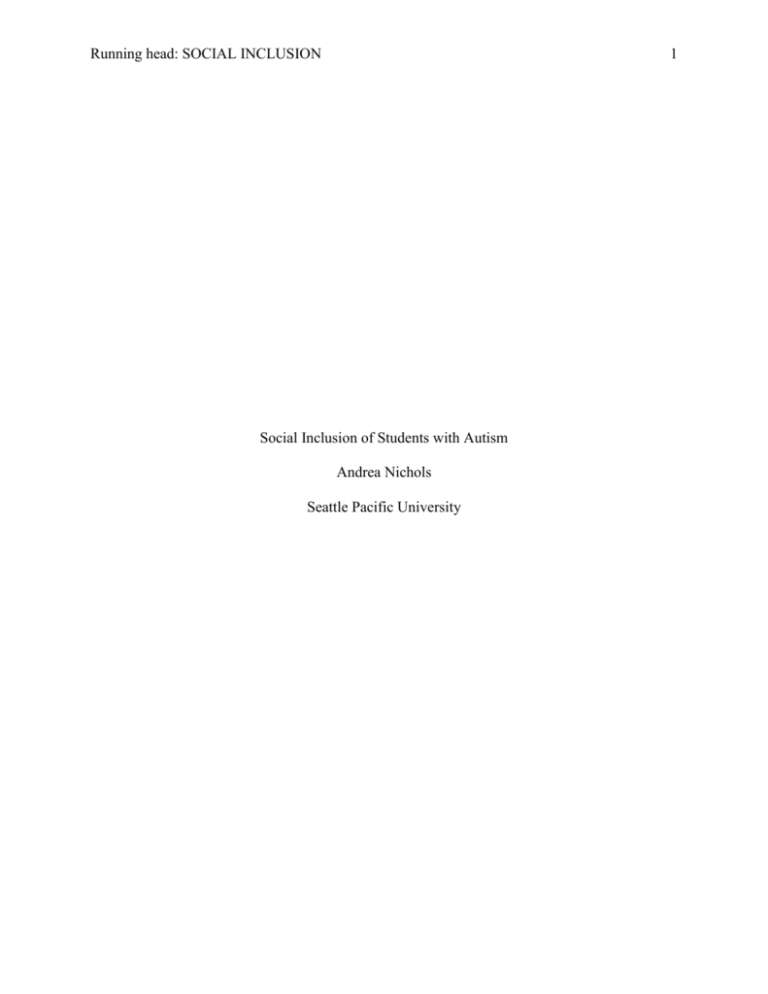
Running head: SOCIAL INCLUSION 1 Social Inclusion of Students with Autism Andrea Nichols Seattle Pacific University SOCIAL INCLUSION 2 Social Inclusion of Students with Autism A widely-held belief in inclusion models of special education is that students with disabilities often find themselves outcasts for one reason or another. When a disability is related to social behavior, it is thought that students would not be able to integrate into social groups or be classmates with whom others would prefer spending time. In 2005, Boutot and Bryant conducted a small-scale study that provided results on the contrary, stating that there was no significant difference in social impact, social preference, or social network affiliation between students with autism or similar disorders and students without such disorders. While the study does not allow for much generalization, as the scope and scale of the study were not very large, it does raise critical questions and provide hope for what teachers can do in the general education classroom to help include students with autism socially. In describing students with autism, Boutot and Bryant note that these students “often have significant social skills deficits that may interfere with their acceptance by others” and they “vary greatly in terms of severity of autism characteristics that may prohibit successful social interactions” (2005, p. 15). Sansosti and Sansosti state that students with autism, even highfunctioning autism, “are at an increased risk of being socially isolated by peers” (2012, p. 917). For these reasons, as well as the fact that many of these students fall behind their peers academically, the major focus of many cases of integration of students with autism in a general education setting is social, as opposed to academic. Inclusion within a general education classroom is thought to benefit students with autism because it “’forces’ children with [autism] to develop new skills because of high expectations from peers and adults, clear standards of appropriate/inappropriate behavior, and availability of positive peer models” (Sansosti and Sansosti, 2012, p. 928). The focus of the Boutot and Bryant study was on what the authors SOCIAL INCLUSION 3 considered to be the three main factors of social integration in a general education classroom – social impact, social preference, and social network affiliation – and how students with autism and similar disorders compare to their counterparts without autism in those areas. Social impact, or a student being known to other students in the classroom, could be considered either a positive or negative social trait. While popular students will often be visible to their peers, so will students who act out in class. For this reason, the Boutot and Bryant believe that autism could create a situation in which students are well-known by their peers, but not necessarily accepted (2005). That is why this survey also included a measure of social preference – determining which students other students would like to be around. In order to measure both of these, the authors used the same survey in which they asked students to choose three students with whom they would like to be grouped and three students with whom they would not like to be grouped for three situations: eating lunch, inviting to a birthday party, and working on a class project. Total times a student’s name was written was tallied for analysis in social impact, while total times a name was positively associated minus the total times a name was negatively associated was used for analysis of social preference. In order to measure social network affiliation, or belonging to a group that spends considerable time together, researchers asked students to identify which students “hang around together a lot” (Boutot and Bryant, 2005, p. 17). By listing names within drawn circles, students identified the most common social groups and wrote people who did not have a social group outside of the circles. Researchers then analyzed which students were often grouped together as well as which students were often left out of any groups. The results of the data were in opposition to what had been hypothesized, as well as findings in other studies: there was no significant difference between the social preference, social SOCIAL INCLUSION 4 impact, or social network affiliation between students with autism and students without learning disabilities in these classrooms. “Students with autism in inclusive classrooms are as likely as their peers to be chosen for an activity…have the same amount of visibility…[and] be members of a very definite group” (Boutot and Bryant, 2005, p. 20). These results promote the idea that students with autism can be successful socially in an inclusive setting. Allowing these students to spend more time in a general education setting, they may be just as likely as other students to form positive relationships with other students and be included socially by their peers. One of the observational findings was very optimistic and indicates a promising avenue for further research. Boutot and Bryant (2005) note that in the two classrooms where other students were prepared for the inclusion of a student with autism by either a parent or an outside consultant, those students had high social preference and high social impact scores. One was even class president. This is an area which deserves more research – discovering how educators can prepare students in a general education classroom to be more socially accepting of students with autism and facilitate the inclusion process for all parties involved. Unfortunately, this survey was very limited in its scope. The data came from 177 students in nine classrooms within the same state. Ten students within this survey group were autistic or had other unspecified disorders and “were receiving special education services under the autism category” (Boutot and Bryant, 2005, p. 16). Two of these students were in the same classroom. All of the students who displayed autistic behaviors were white males who spoke English as a first language and were in the general education classroom for over half of the school day. While narrow in its scope, Boutot and Bryant’s (2005) results provide an optimistic future for the social inclusion of students with autism in a general education setting. Although it is difficult to extrapolate from this data that all students with autism are just as likely to be SOCIAL INCLUSION 5 visible in the classroom, be someone with whom others would wish to spend time, or belong to a social group as their peers, it does show that at the very least this subset of individuals with autism are. By further researching the ways in which students with high social impact, social preference, and social network affiliation are able to socially acclimate in a general education setting, we will be better able to understand what we must do as educators to facilitate that process. SOCIAL INCLUSION 6 References Boutot, E. A. & Bryant, D. P. (2005). Social integration of students with autism in inclusive settings. Education and training in developmental disabilities, 40(1) 14-23. Sansosti, J. M. & Sansosti, F. J. (2012). Inclusion for students with high-functioning autism spectrum disorders: Definitions and decision making. Psychology in the schools, 49(10) 917-931.
